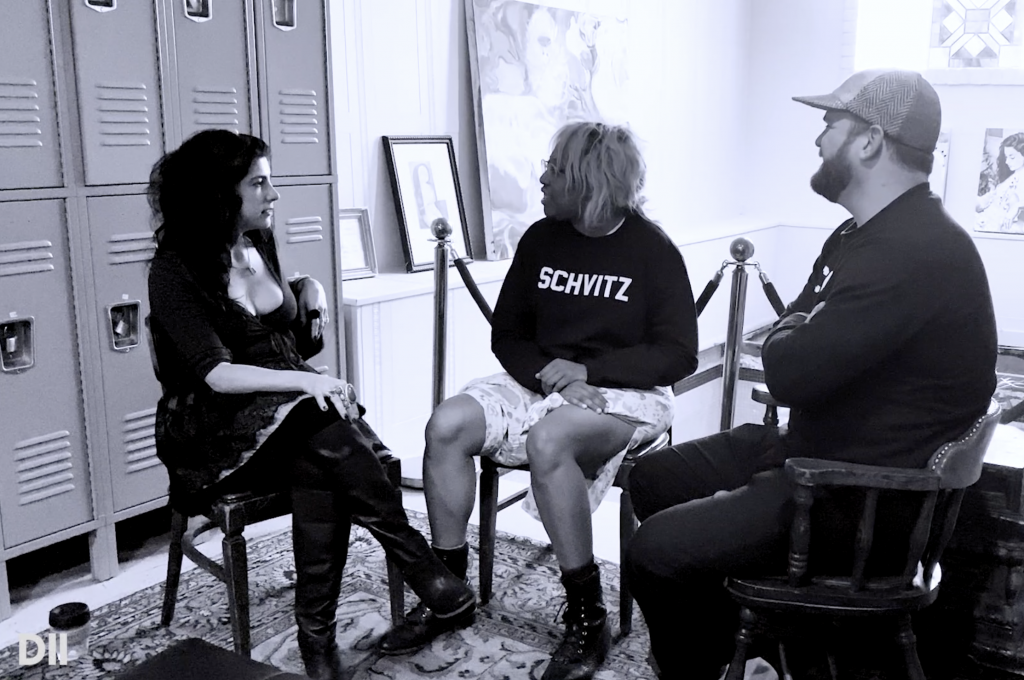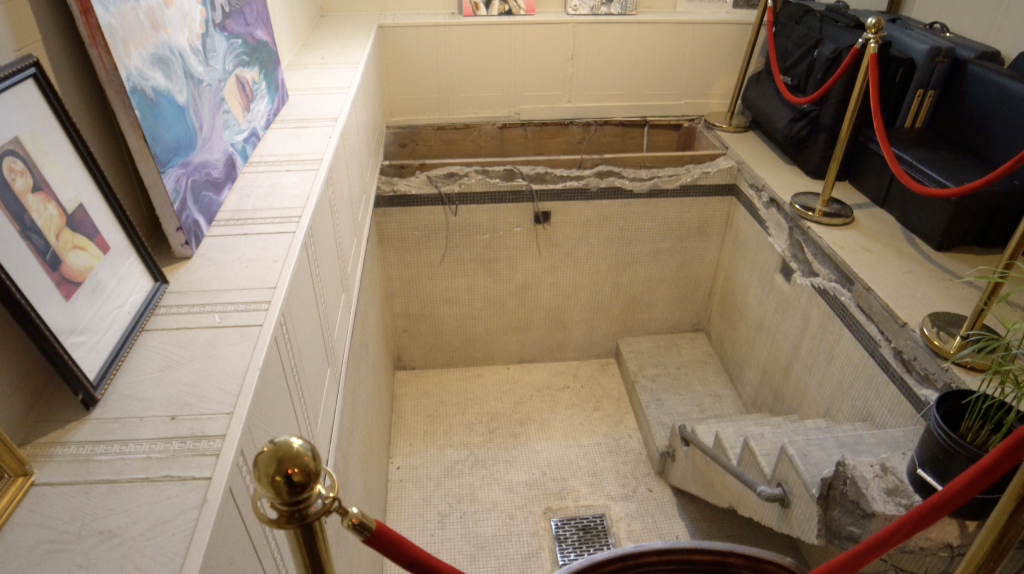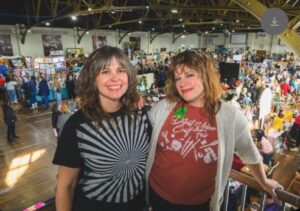I first heard of the Schvitz back in 2008 when I was involved with the Isaac Agree Downtown Synagogue [IADS]. That was the year a group of friends and I rallied to get on the board.
Those were controversial times, partly because we named our first-ever late-night dance party “No Sex in the Synagogue,” in response to my question to filmmaker Oren Goldenberg “What can’t you do in a synagogue?”
And partially because we originally billed ourselves as the last synagogue in Detroit. In our naivete, we failed to mention the other Jewish congregations who had continued meeting in temporary and makeshift spaces, long after all, but one, of our city’s many synagogues had either closed or were converted to churches
But the Isaac Agree Downtown Synagogue was the last freestanding shul, and that’s incredible, considering Detroit is a major U.S. city.
CAFÉ D’MONGO
I was introduced to IADS the way I’d been introduced to most of my favorite parts of Detroit, through my longtime friend, Larry Mongo, of Café d’Mongo. This is the downtown speakeasy once described as “Liberace’s living room.” Back in those days, it was only open on Fridays and the menu had two items. chicken or ribs with three sides: mac and cheese, collard greens and black-eyed peas. Pop by any Thursday and you could catch Larry grilling ribs and chicken on the sidewalk. Stick around to chat long enough and no doubt he would invite you into the empty cafe for a drink.
Larry’s spot and the synagogue sit side-by-side on a block beside Capitol Park. Now, it’s an actual park that opens into an upscale nail salon and fancy restaurant with suburban patrons and a lengthy wine list. There’s valet parking and ‘no loitering’ signs. This used to be where the city buses gathered and where I lived, in the famous 1217 Griswold building. Rents were cheap—$500 monthly for 2,300 sq ft—but everything was DIY. Everything. Including custom showers and walls.
This was where I was coming from on the unassuming day when Larry dragged me, and my boyfriend, to the synagogue’s mysterious red doors and knocked. Then-Vice President, DaVid Powell, appeared, and the rest is a very, very, long story.
The plot of which centers around Larry arguing that we, as Jewish people, needed to do something, because the current board was considering selling the building to the strip club across the street. During my time on the block, the club had many names, but at this moment, I believe it was the Grind. It’s now some sort of micro-apartment situation with a burger spot and a barre studio below.
Larry called it the Art Gallery. To be honest, it was full of fine people, some of whom I considered solid acquaintances. But, even we, as mostly non-observing Jews, couldn’t stomach the idea of a strip club replacing the city’s last Jewish temple.
Whether or not the building was actually in danger of being sold to the strip club, is another matter entirely. Those who spend time with Larry know the truth isn’t as much about facts at it and perception. Larry knew that our perception of this threat was just the villain we needed to energize our efforts to revitalize the temple.
Maybe he was just hoping we’d bring some grants to beautify the old building, and by proxy, his block. It would have been a sound plan. I, of course, am jesting.
Regardless, the plan worked. Today IADS is the nexus of Detroit’s rich and (re)expanding Jewish community.
RABBI A
Larry cared about the synagogue. So much so that at the beginning of our efforts, he paid one of his kitchen staff to help me clear out the third floor of the building.
This is where the rabbi—let’s call him Rabbi A—once lived. I’m certain Rabbi A wasn’t an official rabbi. He just liked the title. Of course, I don’t know much about him other than the fact that he worked for as a trolly driver. Yes, long before the Qline, downtown Detroit had a trolly, and one of its drivers lived in Capitol Park’s pie-shaped synagogue, where he moonlighted as a rabbi. Rabbi A was rumored to have answered the temple’s door in his bathrobe. On more than one occasion.
There were many stories. The only one I can confirm is of the fascinating objects I found in his former living space—old trolley tickets, a pair of ladies’ underwear, a box of bullets. Larry’s cook and I carried many, many black garbages bags out to the dumpster that day.
We did not carry out the mattress or the bench press.
When I heard the stories of how Paddy Lynch found the Schvitz, this is where my mind went.
THE SCHVITZ DETROIT

THE SCHVITZ DETROIT. PHOTO ACRONYM
The building that houses the Schvitz was constructed in Detroit’s North End, a historically Jewish neighborhood, around 1918. It started its life as the Jewish Community Center.
It was during this period that mikveh was built. A mikveh is, to borrow the dictionary’s terms,“a bath in which certain Jewish ritual purifications are performed.” Like getting married or ending your menstruation period or celebrating an event of a holiday. The Jewish religion has a lot of rituals, and therefore a lot of reasons to the mikveh.
A hundred years ago, this mikveh helped to comprise the spiritual foundation for an entire community of people, mostly Russian-Jews. It was a big deal.
FAST FORWARD
By 1930, the community center had become the Oakland Baths (aka the Schvitz) and something of a second home for the Russian population who grew up schvitzing. Eventually, it became a hangout for the infamous Jewish gangsters, the Purple Gang, and later earned a reputation for having one of the best steak dinners in town. At one point, a man named Toots dug a swimming pool in the basement, by hand.
Somewhere in there, someone covered up the mikveh. Some say it happened in the early 1950s, but no one seems to know for sure.
TWIN FLAMES
It would be impossible for me to untangle the Schvitz from my experience with IADS. The word was everywhere. This was the place where Jewish men came to sweat and eat steak dinners in robes. They shared hearty belly laughs and smoked and played cards and whatever other things men do alone with each other. So I imagined.
Women weren’t permitted—except on couples’ night or, as it was more often referred to, swingers’ night.
To clarify, this was not a sex-positive swingers’ night my poly friends might organize on an online forum. It was an unofficial swingers’ night, spoken of in hushed tones and involving not sex workers but ladies of the night. The idea felt archaic and oppressive and was, I hope, made worse by my overactive imagination.
Mark Kurlyandchick describes the situation most eloquently in his 2016 piece for Hour Detroit Magazine.
“But it’s the freaky stuff that goes on upstairs on Saturday nights that earns the Schvitz its slightly lurid reputation. Saturday is “Couple’s Night,” Detroit’s 40-year-old little-kept secret spot for indulging in the swinger lifestyle. There are only two rules to Couple’s Night: You must show up as a one-man, one-woman couple, and no money is to be exchanged. After that, almost anything goes.”
Despite this sordid part of the myth, I intuited that there something uniquely special about the Schvitz. Beyond the awful things that transpired here, there was a thread of good that was never severed. The debauchery and the experience of Schvitzing were separate the same way the people who had been coming to worship in the sanctuary of IADS for decades were different from the things that happened on the third floor.
As Kurlyandchick continues, “But on Sundays — our days — there are only Dima’s nonspecific stories of the night before and bashful smiles of men with imaginations but no firsthand experiences.”
Don’t throw the baby out with the bathwater, as my dear friend and earlier supported of IADS, Kathryn Lindberg would say.
This is the feeling I got when I first interviewed Paddy Lynch about his home away from home: there was something about the comradery of steam that compelled him to frequent the Schvitz and eventually take out a mortgage on his home to purchase it.
Over a decade ago, the Isaac Agree Downtown Synagogue and the Schvitz were two of Detroit’s last great Jewish institutions. Like the rest of the city, they had seen hard times—and had been shaped by them. The fact that both were still active speaks to a power that transcends Judaism.
You didn’t have to be Jewish to feel the magic in IADS. And you certainly don’t have to be Jewish to feel the generations of devotion to the Schvitz. In part, because not all of that devotion was Jewish, but hold that thought.
THE MIKVEH

THE MIKVEH INSIDE THE SCHVITZ DETROIT. PHOTO ACRONYM
Torya Schoeniger has made the Schvitz a safe space for all people. Ok, to be fair, this has been the hard work of a handful of individuals, including a determined human named Jessie Nigl, but that’s another story. Torya got the ball rolling—and she’s still rolling it.
A few years back, she petitioned to hold a ladies’ brunch at the Schvitz. Her husband, John, was a regular there, along with her friend Paddy. After hearing them go on about the joys of sweating and socializing, she wanted in too.
It was a bold move, as it was a men’s club. In every sense of the word. And a filthy one at that.
What is now the ladies’ locker room, served as the couples’ room, the unofficial smoking room on men’s night and the adult movie viewing room. As Paddy recounts, this was the most desecrated room in the building. And unwelcoming to most people—especially those looking to enjoy a healthful Sunday meal. Building a brunch crowd meant making space for a brunch crowd. Thus, the cleanup began.
Like IADS, the Schvitz is a multi-level building. Similarly, both once featured upper levels with makeshift bedrooms that contained many things you wouldn’t expect to find—such as extra mattresses and adult literature. When I hear the list items excavated from the Schvitz, my heart goes out to Torya and those early pioneers of women-Schvitzers.
The momentum generated from ladies’ brunch carried into Paddy’s purchase of the building, immediately after which he and Torya introduced ladies only days and replaced couples’ night with bathing suit mandatory co-ed nights. I promise you, today there is no secret swingers’ night.
Repairs were made to the building, garbage dumpsters filled and the carpet was ripped out and replaced with the original floors.
DISCOVERY
There were rumors a mikveh existed in the building, but most were convinced it had long been destroyed. No way was it still there. Except it was. Beneath the carpet, on the far side of the couples’ room—now the ladies’ locker room—were boards. And under these boards, where they expected to find original floors, was an original mikveh.
If you’ve never seen a mikveh, imagine a dipping pool. This one’s quite elegant, comprised of many small tiles and a slender staircase in the corner.
This is where an entire community took their aches and joys and sorrows to be purified. The most debased room in the space was revealed to be the most sacred.
LESSONS
I’m not a regular at the Schvitz. While I enjoy sweating and appreciate its benefits, what draws me here is the same thing that drew me to IADS: the people.
I will forever be in debt to the city’s last synagogue for deepening my understanding of the Jewish faith and culture—and for connecting me with the people of Detroit and its rich history.
During my time on the board of IADS, I met people and heard stories that would transform my life. My first understanding of the North End came from a kind woman who invited me into her home to share her experience growing up here. These were stories colored with Purim celebrations and trips to the local fishmonger, where her mother bought live fish she kept in the bathtub, before serving them for dinner.
This is also where I met the artist DeVon Cunningham, who studied at the synagogue under the late Rabbi Noah Gamze. And where I heard him recount the way Abe Bernstein, the infamous leader of the Purple Gang, protected the temple after someone threw a brick through the window.
This is the same Bernstein who took a young DeVon Cunningham to steam at the Schvitz for the first time.
It was through IADS that I first met Jerry and Paffendorf and Mary Lorene Carter of LOVELAND. One summer, IADS joined forces with LOVELAND and Cafe d’Mongo to throw a Big Inch Block Party. A crowd of partiers spilled into the street along with the Detroit Party Marching Band. The cars moved about us. No one bothered to file for a permit, but no one needed to.
Here, at IADS’s late-night parties, I witnessed young people stepping into a temple for the first time in their lives. Some Jewish. Some not. I had the honor of accompanying some of these folks into the sanctuary and witnessing their first meaningful encounter with Judaism. In the same way, a visit to the Schvitz and the mikveh might be one’s first encounter with Judaism and its rich cultural legacy.
Which is important to all Detroiters, as it’s part of our collective history. That’s what the synagogue taught me: the story of one people cannot be extracted from its neighbors.
COMING HOME
The Isaac Agree Downtown Synagogue grew out of The Isaac Agree Memorial Society, formed in 1921. Before establishing a home in the former Fyntex department store, the Isaac Agree congregation met in a house on the North End, not far from the Schvitz. And not too far from the spot where Larry’s uncle opened Red’s Shoe Shine. His cousin still runs it. To this day, he swears it’s the reason crime doesn’t touch the bathhouse.
In a city that is constantly changing, these through lines are rare—and sacred.
Cafe d’Mongo will always be Cafe d’Mongo, but it’s patrons and surroundings are completely new. Downtown is no longer the eclectic mecca for artists, intellectuals, politicians, etc., etc…
Over a decade ago, Cafe d’Mongo is where I first met Paddy, a young funeral director, and Torya, proprietor of Good Girls Go To Paris. Before Detroit’s culinary moment, Torya was often serving Detroiters some of the best damn crepes I’ve ever tasted. Back then, Don Barden was still alive and came into the cafe every Friday for happy hour.
And almost every Friday someone would come into the club who Larry insisted needed to see the synagogue, and he’d relieve me from my bartending duties to send me down the block on an impromptu tour.
It was a special place where you could strike up conversations with people who would become lifelong friends. I never expected to find another place this special in Detroit until I discovered the Schvitz.
On Sundays by 12:30 pm, there’s a line around the block for ladies brunch. No longer a potluck affair, it’s become a place for young chefs to test out their concepts. Each week, the same family of practitioners sets up shop, offering massage, reiki, vitamin shops, and tarot readings. Since purchasing the building, Paddy has added as salt room to the offerings. Still, it’s not the most state-of-the-art steaming facility. People come here for the same reasons they’ve always come here: to steam and connect.
In a few short years, the Schvitz has attracted a following of ladies as devoted as the men who’ve been coming here for decades. One regular named Lily, who works at the Schvitz giving platza treatments, is a fourth-generation Schvitzer!
After unearthing the Mikveh, Torya and Paddy fought over what to do with it. It being, in most basic terms, a giant hole in the ladies’ locker room. Maybe they should cover it back up, Torya argued, so no one falls in. A logical thought, but Paddy won: the hole remained and a velvet rope was placed around it.
“It had been covered up too long,” Paddy asserted, “it’s time for it to breathe.”

















